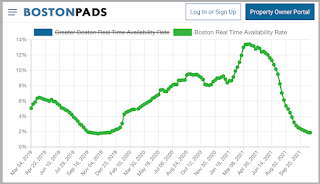Boston Apartment Availability Drops 87% In Six Months In Rapid Recovery
Boston’s apartment availability percentage has been on a wild ride over the past 24 months. In October of 2019, apartment availability was near an all-time low at 1.74% following a decade of growing demand for rental units in Greater Boston. In 2020, it rapidly climbed to its highest level in more than a decade and peaked at 13.43% in March, more than double its cyclical high in March of 2019 (5.56%). Since then, apartment availability has been in a free fall, and is beginning to flatten at 1.97%, very close to its level in October 2019. That marks an 87.04% drop in availability rate in just 7 months for Boston apartments.
To state the obvious, the pandemic was the main contributing factor in all of this volatility. But why such a huge swing in both directions? Boston is no stranger to high apartment turnover. Historically, the availability percentage has fluctuated between 2% and 8% every year, with its peak occurring in March/April and its low in October/November. This trend is so reliable, you could set your watch to it.
This cycle is driven by off campus housing demand. Boston’s student population is well over 100,000, and the majority of these students live in off campus. So at any given time in Boston, roughly 50% of apartments are students who typically don’t stay in the same place for more than a few years. As a result, the apartment supply breathes with the academic calendar, and the majority of leases begin and end on September 1. If you don’t believe me, just Google ‘Allston christmas’.
That being said, when the majority of schools opted for remote learning in 2020, the effects on the local rental market were resounding. The availability rate continued to climb throughout April, May, and well into the summer when it is usually rapidly declining. Without students, Boston’s housing supply was left empty, and the vacancy rate shot up to an unprecedented 9.1% in September.
The availability rate continued to climb throughout the first quarter of 2021 until around March, where it can be seen reversing course and rapidly declining over the next 7 months. So what happened in March? This is when most of Boston’s largest universities announced plans to have in-person learning for Fall 2021 semester. The market reacted accordingly, as we saw a massive rush of students coming back to Boston. Now it appears as its business as usual for Boston’s apartment rental market, and the supply of apartments for rent in Boston is as tight as its ever been.

Comments
Post a Comment